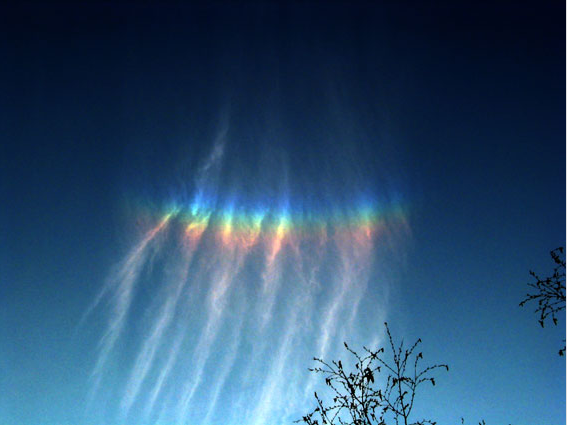Circumzenithal Arc, Germany
Circumzenithal Arc, Germany: A Spectacular Atmospheric Phenomenon
Have you ever looked up at the sky and seen a mesmerizing display of colors and arcs? One such captivating phenomenon is the Circumzenithal Arc (CZA), which can be observed in various parts of the world, including Germany. The CZA is a rare optical phenomenon that occurs when sunlight interacts with ice crystals in the atmosphere, creating a stunning arc of colors that seems to defy gravity. In this article, we will explore the science behind the Circumzenithal Arc and its occurrence in Germany.
What is a Circumzenithal Arc?
A Circumzenithal Arc is an atmospheric optical phenomenon that forms a vibrant arc of colors in the sky. It is often referred to as an "upside-down rainbow" due to its resemblance to a traditional rainbow. However, unlike a rainbow that forms when sunlight is refracted and reflected through raindrops, a CZA is formed by the refraction of sunlight through ice crystals in high-altitude cirrus clouds.
The Science Behind the Circumzenithal Arc
To understand how a Circumzenithal Arc is formed, we need to delve into the science of light refraction and ice crystal formation. When sunlight passes through hexagonal ice crystals, it undergoes refraction, bending at specific angles. The hexagonal shape of the ice crystals determines the angle at which sunlight is refracted, causing it to separate into its constituent colors.
The Circumzenithal Arc occurs when sunlight enters the top face of the hexagonal ice crystals, undergoes refraction, and exits through one of the side faces. This refraction process causes the sunlight to disperse into its spectral colors, creating the vibrant arc seen in the sky. The angle at which the sunlight enters and exits the ice crystals determines the curvature and size of the arc.
Observing the Circumzenithal Arc in Germany
Germany, with its diverse climate and atmospheric conditions, provides a wonderful opportunity for observing the Circumzenithal Arc. The best time to witness this phenomenon is during the colder months when cirrus clouds, which consist of ice crystals, are more prevalent in the sky.
When the sun is relatively low in the sky, typically in the morning or late afternoon, the conditions are ideal for the formation of a CZA. The sunlight interacts with the ice crystals in the cirrus clouds, creating a stunning display of colors that can be seen from the ground.
The Colors of the Circumzenithal Arc
The Circumzenithal Arc is known for its vibrant colors, which are similar to those of a rainbow. However, unlike a rainbow that displays a continuous spectrum of colors, a CZA exhibits a more concentrated range of colors. The arc usually appears as a vivid band of reds and oranges near the top, transitioning to blues and purples towards the bottom.
The reason for this color concentration is due to the specific angles at which sunlight is refracted through the ice crystals. Each color of light has a different wavelength, and as sunlight passes through the ice crystals, each color bends at a slightly different angle, resulting in the separation of colors along the arc.
Capturing the Circumzenithal Arc
If you are lucky enough to witness a Circumzenithal Arc in Germany, it is undoubtedly a sight worth capturing. To photograph this breathtaking phenomenon, it is best to use a wide-angle lens to capture the entire arc. Adjusting the exposure settings to balance the brightness of the sky and the arc will help bring out the vibrant colors.
Remember to position yourself in a location with an unobstructed view of the sky, away from tall buildings or trees that may block your view. Patience is key, as the appearance of a Circumzenithal Arc is relatively rare and may require waiting for the right atmospheric conditions.
Other Atmospheric Optics Phenomena in Germany
Germany is not only home to the Circumzenithal Arc but also offers opportunities to witness other fascinating atmospheric optics phenomena. Here are a few notable examples:
-
Halos: Halos are rings of light that form around the sun or moon due to the refraction and reflection of light by ice crystals or water droplets in the atmosphere. These beautiful rings can vary in size and color, creating a captivating spectacle in the sky.
-
Sun Pillar: A sun pillar is a vertical column of light that appears above or below the sun when sunlight reflects off ice crystals in the atmosphere. This phenomenon creates a stunning pillar of light that seems to extend infinitely into the sky.
-
Parhelic Circle: The parhelic circle is a rare optical phenomenon that forms a circular band of light around the sun. It occurs when sunlight is refracted and reflected by ice crystals in the atmosphere, creating a halo-like effect.
Conclusion
The Circumzenithal Arc is a remarkable atmospheric optics phenomenon that graces the skies of Germany with its vibrant colors and ethereal beauty. Understanding the science behind this phenomenon and knowing when and where to observe it can greatly enhance your chances of witnessing this awe-inspiring display of nature's wonders. So, keep your eyes to the sky, for you never know when the next Circumzenithal Arc will grace the heavens above Germany.

A CZA lights threads of early morning cirrus. Imaged by Eva Seidenfaden (Atmospheric Optics) in April '03. ©2003 Eva Seidenfaden, shown with permission
Note: this article has been automatically converted from the old site and may not appear as intended. You can find the original article here.
Reference Atmospheric Optics
If you use any of the definitions, information, or data presented on Atmospheric Optics, please copy the link or reference below to properly credit us as the reference source. Thank you!
-
<a href="https://atoptics.co.uk/blog/circumzenithal-arc-germany/">Circumzenithal Arc, Germany</a>
-
"Circumzenithal Arc, Germany". Atmospheric Optics. Accessed on April 18, 2024. https://atoptics.co.uk/blog/circumzenithal-arc-germany/.
-
"Circumzenithal Arc, Germany". Atmospheric Optics, https://atoptics.co.uk/blog/circumzenithal-arc-germany/. Accessed 18 April, 2024
-
Circumzenithal Arc, Germany. Atmospheric Optics. Retrieved from https://atoptics.co.uk/blog/circumzenithal-arc-germany/.